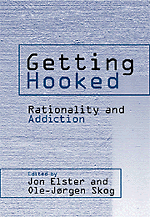Book contents
- Frontmatter
- Contents
- Preface and Acknowledgments
- Contributors
- Introduction
- Addiction and Social Interaction
- Addiction, Weakness of the Will, and Relapse
- The Dangers of Willpower
- The Neurobiology of Chemical Addiction
- To Legalize or Not to Legalize: Is That the Question?
- Rationality, Irrationality, and Addiction – Notes on Becker's and Murphy's Theory of Addiction
- Gambling and Addiction
- A Visceral Account of Addiction
- Epilogue: Rationally Coping with Lapses from Rationality
- Index
A Visceral Account of Addiction
Published online by Cambridge University Press: 05 June 2012
- Frontmatter
- Contents
- Preface and Acknowledgments
- Contributors
- Introduction
- Addiction and Social Interaction
- Addiction, Weakness of the Will, and Relapse
- The Dangers of Willpower
- The Neurobiology of Chemical Addiction
- To Legalize or Not to Legalize: Is That the Question?
- Rationality, Irrationality, and Addiction – Notes on Becker's and Murphy's Theory of Addiction
- Gambling and Addiction
- A Visceral Account of Addiction
- Epilogue: Rationally Coping with Lapses from Rationality
- Index
Summary
In the past, addiction has been viewed as a sui generis phenomenon (Baker 1988). Recent theories of addiction, however, draw implicit or explicit parallels between addiction and a wide range of other behavioral phenomena. The “disease theory,” for example, highlights similarities between addiction and infectious disease (e.g., Frawley [1988], Vaillant [1983]). Becker and Murphy's rational-choice model of addiction draws a parallel between drug addictions and “endogenous taste” phenomena, such as listening to classical music to attempt to acquire a taste for it, in which current consumption affects the utility of future consumption (Becker and Murphy 1988). Herrnstein and Prelec's “garden path” theory sees addiction as analogous to bad habits, such as workaholism or compulsive lying, that can be acquired gradually due to a failure to notice a deterioration in one's conduct or situation (Herrnstein and Prelec 1992).
In this chapter, I propose an alternative theoretical perspective that views addiction as one, albeit extreme, example of a wide range of behaviors that are influenced or controlled by “visceral factors” (Loewenstein 1996). Visceral factors include drive states such as hunger, thirst, and sexual desire, moods and emotions, physical pain, and, most importantly for addiction, craving for a drug. All visceral factors, including drug craving, are associated with regulatory mechanisms that are essential for survival, but all are also associated with behavior disorders (e.g., sleepiness and narcolepsy, hunger and overeating, fear and phobias, sexual desire and sexual compulsions, anger and spousal abuse, craving and addiction).
- Type
- Chapter
- Information
- Getting HookedRationality and Addiction, pp. 235 - 264Publisher: Cambridge University PressPrint publication year: 1999
- 55
- Cited by

